Quantifying the Low Salinity Waterflooding Effect
Abstract
:1. Introduction
2. Experimental Materials and Methods
2.1. Crude Oil
2.2. Brines
2.3. Rock Sample Preparation Procedure
2.4. Coreflood Setup and Experimental Conditions
2.5. Quantitative Unsteady-State Coreflood Tests
3. Numerical Methods
3.1. Mathematical Model
3.2. Capturing the Capillary End Effect
4. Results and Discussion
4.1. Experimental Results
4.1.1. First Coreflooding Experiment (USS-1)
4.1.2. Second Coreflooding Experiment (USS-2)
4.1.3. Comparison between USS-1 and USS-2
4.2. Numerical Results
4.2.1. Verification of the Mathematical Model
4.2.2. Numerical Interpretation of the Experiments
5. Summary and Conclusions
- In the quantitative USS-1 test, the injection of LSW in tertiary mode resulted in an incremental oil recovery of 1%. However, the incremental oil was only recovered after bumping up the flow rate from 0.3 cm3/min to 1 cm3/min. This implies that LSW successfully mobilized some of the trapped oil. However, the pressure drop by LSW was not high enough to overcome the modified capillary pressure and only after inducing higher pressure drop, by virtue of increasing the flow rate, was the oil recovered.
- Comparing the secondary mode of both USS-1 and USS-2, the results show the potential of LSW in increasing the oil recovery by wettability alteration or reducing the remaining oil saturation. At a typical field rate of ~1 ft/day, LSW resulted in not only ~20% higher oil recovery compared to FW but also recovered oil sooner.
- The development of a verified mathematical model with the appropriate assumptions and boundary conditions confirmed the physical plausibility of the USS coreflooding experiments and provided a better understanding of the history matching process.
- The numerically extracted relative permeability curves confirmed the potential of LSW in enhancing oil recovery by altering the wettability of the rock towards less oil-wet. It also lays the foundation to quantifying the LSW effect at full field scale.
Author Contributions
Funding
Conflicts of Interest
References
- Bernard, G. Effect of floodwater salinity on recovery of oil from cores containing clays. In Proceedings of the SPE California Regional Meeting, Los Angeles, CA, USA, 26 October 1967. [Google Scholar] [CrossRef]
- Tang, G.; Morrow, N. Salinity, temperature, oil composition, and oil recovery by waterflooding. SPE Res. Eng. 1997, 12, 269–276. [Google Scholar] [CrossRef]
- Morrow, N.; Buckley, J. Improved oil recovery by low-salinity waterflooding. J. Pet. Technol. 2011, 63, 106–112. [Google Scholar] [CrossRef]
- Sheng, J.J. Critical review of low-salinity waterflooding. J. Pet. Sci. Eng. 2014, 120, 216–224. [Google Scholar] [CrossRef]
- Hognesen, E.J.; Strand, S.; Austad, T. Waterflooding of preferential oil-wet carbonates: Oil recovery related to reservoir temperature and brine composition. In Proceedings of the SPE Europec/EAGE Annual Conference, Madrid, Spain, 13 June 2005. [Google Scholar] [CrossRef]
- Webb, K.J.; Black, C.J.J.; Tjetland, G. A laboratory study investigating methods for improving oil recovery in carbonates. In Proceedings of the SPE International Petroleum Technology Conference, Doha, Qatar, 21 November 2005. [Google Scholar] [CrossRef]
- Zhang, P.; Tweheyo, M.T.; Austad, T. Wettability alteration and improved oil recovery by spontaneous imbibition of seawater into chalk: Impact of the potential determining ions Ca2+, Mg2+, and SO42−. Colloid Surf. 2007, 301, 199–208. [Google Scholar] [CrossRef]
- Strand, S.; Puntervold, T.; Austad, T. Effect of temperature on enhanced oil recovery from mixed-wet chalk cores by spontaneous imbibition and forced displacement using seawater. Energy Fuels 2008, 22, 3222–3225. [Google Scholar] [CrossRef]
- Romanuka, J.; Hofman, J.; Ligthelm, D.J.; Suijkerbuijk, B.; Marcelis, F.; Oedai, S.; Brussee, N.; van der Linde, H.; Aksulu, H.; Austad, T. Low salinity EOR in carbonates. In Proceedings of the SPE Improved Oil Recovery Symposium, Tulsa, OK, USA, 14 April 2012. [Google Scholar] [CrossRef]
- Bagci, S.; Kok, M.V.; Turksoy, U. Effect of brine composition on oil recovery by waterflooding. J. Pet. Sci. Technol. 2001, 19, 359–372. [Google Scholar] [CrossRef]
- Gupta, R.; Smith, P.G.J.; Hu, L.; Willingham, T.W.; Cascio, M.L.; Shyeh, J.J.; Harris, C.R. Enhanced waterflood for middle east carbonate cores–impact of injection water composition. In Proceedings of the SPE Middle East Oil and Gas Show and Conference, Manama, Bahrain, 25 September 2011. [Google Scholar] [CrossRef]
- Yousef, A.A.; Al-Saleh, S.H.; Al-Kaabi, A.; Al-Jawfi, M.S. Laboratory investigation of the impact of injection-water salinity and ionic content on oil recovery from carbonate reservoirs. SPE Reserv. Eval. Eng. 2011, 14, 578–593. [Google Scholar] [CrossRef]
- Zahid, A.; Shapiro, A.; Skauge, A. Experimental studies of low salinity water flooding in carbonate reservoirs: A new promising approach. In Proceedings of the SPE EOR Conference at Oil and Gas West Asia, Muscat, Oman, 16 April 2012. [Google Scholar] [CrossRef]
- Chandrasekhar, S.; Mohanty, K.K. Wettability alteration with brine composition in high temperature carbonate. In Proceedings of the SPE Annual Technical Conference and Exhibition, New Orleans, LA, USA, 30 September 2013. [Google Scholar] [CrossRef] [Green Version]
- Al-Attar, H.H.; Mahmoud, M.Y.; Zekri, A.Y.; Almehaideb, R.A.; Ghannam, M.T. Low Salinity Flooding in a Selected Carbonate Reservoir: Experimental Approach. In Proceedings of the EAGE Annual Conference & Exhibition Incorporating SPE Europec, London, UK, 10 June 2013. [Google Scholar] [CrossRef]
- Awolayo, A.; Sarma, H.; AlSumaiti, A.M. A laboratory study of ionic effect of smart water for enhancing oil recovery in carbonate reservoirs. In Proceedings of the SPE EOR conference at oil and gas West Asia, Muscat, Oman, 31 March 2014. [Google Scholar] [CrossRef]
- Nasralla, R.A.; Mahani, H.; van der Linde, H.A.; Marcelis, F.H.; Masalmeh, S.K.; Sergienko, E.; Brussee, N.J.; Pieterse, S.G.; Basu, S. Low salinity waterflooding for a carbonate reservoir: Experimental evaluation and numerical interpretation. J. Petrol. Sci. Eng. 2018, 164, 640–654. [Google Scholar] [CrossRef]
- Feldmann, F.; Strobel, G.J.; Masalmeh, S.K.; AlSumaiti, A.M. An experimental and numerical study of low salinity effects on the oil recovery of carbonate rocks combining spontaneous imbibition, centrifuge method and coreflooding experiments. J. Petrol. Sci. Eng. 2020, 190. [Google Scholar] [CrossRef]
- Yousef, A.A.; Al-Saleh, S.; Al-Jawfi, M.S. Improved/enhanced oil recovery from carbonate reservoirs by tuning injection water salinity and ionic content. In Proceedings of the SPE improved oil recovery symposium, Tulsa, OK, USA, 14 April 2012. [Google Scholar] [CrossRef]
- Zhang, P.; Austad, T. Wettability and oil recovery from carbonates: Effects of temperature and potential determining ions. Colloid Surf. 2006, 279, 179–187. [Google Scholar] [CrossRef]
- Austad, T.; Shariatpanahi, S.F.; Strand, S.; Black, C.J.J.; Webb, K.J. Conditions for a low-salinity enhanced oil recovery (EOR) effect in carbonate oil reservoirs. Energy Fuels 2012, 26, 569–575. [Google Scholar] [CrossRef]
- Hiorth, A.; Cathles, L.M.; Madland, M.V. The impact of pore water chemistry on carbonate surface charge and oil wettability. Transp. Porous Media 2010, 85, 1–21. [Google Scholar] [CrossRef]
- Zaretskiy, Y. Towards Modelling Physical and Chemical Effects during Wettability Alteration in Carbonates at Pore and Continuum Scales. Ph.D. Thesis, Heriot-Watt University, Edinburgh, UK, 2012. Available online: http://hdl.handle.net/10399/2543 (accessed on 11 June 2019).
- Nasralla, R.A.; Sergienko, E.; Masalmeh, S.K.; van der Linde, H.A.; Brussee, N.J.; Mahani, H.; Suijkerbuijk, B.M.; Al-Qarshubi, I.S. Potential of low-salinity waterflood to improve oil recovery in carbonates: Demonstrating the effect by qualitative coreflood. SPE J. 2016, 21, 1643–1654. [Google Scholar] [CrossRef]
- Masalmeh, S.K.; Sorop, T.G.; Suijkerbuijk, B.M.; Vermolen, E.C.M.; Douma, S.; Van Del Linde, H.A.; Pieterse, S.G.J. Low salinity flooding: Experimental evaluation and numerical interpretation. In Proceedings of the International Petroleum Technology Conference, Doha, Qatar, 19 January 2014. [Google Scholar] [CrossRef]
- Berg, S.; Unsal, E.; Dijk, H. Non-uniqueness and uncertainty quantification of relative permeability measurements by inverse modelling. Comput. Geotech. 2021, 132. [Google Scholar] [CrossRef]
- Chang, D.; Vinegar, H.J.; Morriss, C.; Straley, C. Effective porosity, producible fluid and permeability in carbonates from NMR logging. In Proceedings of the SPWLA 35th Annual Logging Symposium, Tulsa, OK, USA, 19 June 1994. [Google Scholar]
- Masalmeh, S.K. Determination of waterflooding residual oil saturation for mixed to oil-wet carbonate reservoir and its impact on EOR. In Proceedings of the SPE Reservoir Characterization and Simulation Conference and Exhibition, Abu Dhabi, United Arab Emirates, 16 September 2013. [Google Scholar] [CrossRef]
- Sheldon, J.W.; Cardwell Jr, W.T. One-dimensional, incompressible, noncapillary, two-phase fluid flow in a porous medium. Trans. AIME 1959, 216, 290–296. [Google Scholar] [CrossRef]
- Aziz, K.; Settari, A. Multiphase Flow in One Dimension. In Petroleum Reservoir Simulation, 1st ed.; Applied Science Publishers: Calgary, Canada, 1979; Volume 1, pp. 125–199. [Google Scholar]
- Lie, K.A. Introduction. In An Introduction to Reservoir Simulation Using MATLAB/GNU Octave: User Guide for the MATLAB Reservoir Simulation Toolbox (MRST), 1st ed.; Cambridge University Press: Cambridge, UK, 2019; Volume 1, pp. 1–17. [Google Scholar] [CrossRef] [Green Version]
- LeVeque, R.J. Finite volume methods. In Finite Volume Methods for Hyperbolic Problems, 1st ed.; Cambridge University Press: Cambridge, UK, 2002; Volume 31, pp. 64–85. [Google Scholar]
- Lenormand, R.; Lorentzen, K.; Maas, J.G.; Ruth, D. Comparison of four numerical simulators for SCAL experiments. Petrophysics 2017, 58, 48–56. [Google Scholar]
- Brooks, R.H.; Corey, A.T. Hydraulic properties of porous media and their relation to drainage design. Trans. ASAE 1964, 7, 26–28. [Google Scholar]
- Sorop, T.G.; Masalmeh, S.K.; Suijkerbuijk, B.M.; van der Linde, H.A.; Mahani, H.; Brussee, N.J.; Marcelis, F.A.; Coorn, A. Relative permeability measurements to quantify the low salinity flooding effect at field scale. In Proceedings of the SPE Abu Dhabi International Petroleum Exhibition and Conference, Abu Dhabi, United Arab Emirates, 9 November 2015. [Google Scholar] [CrossRef]
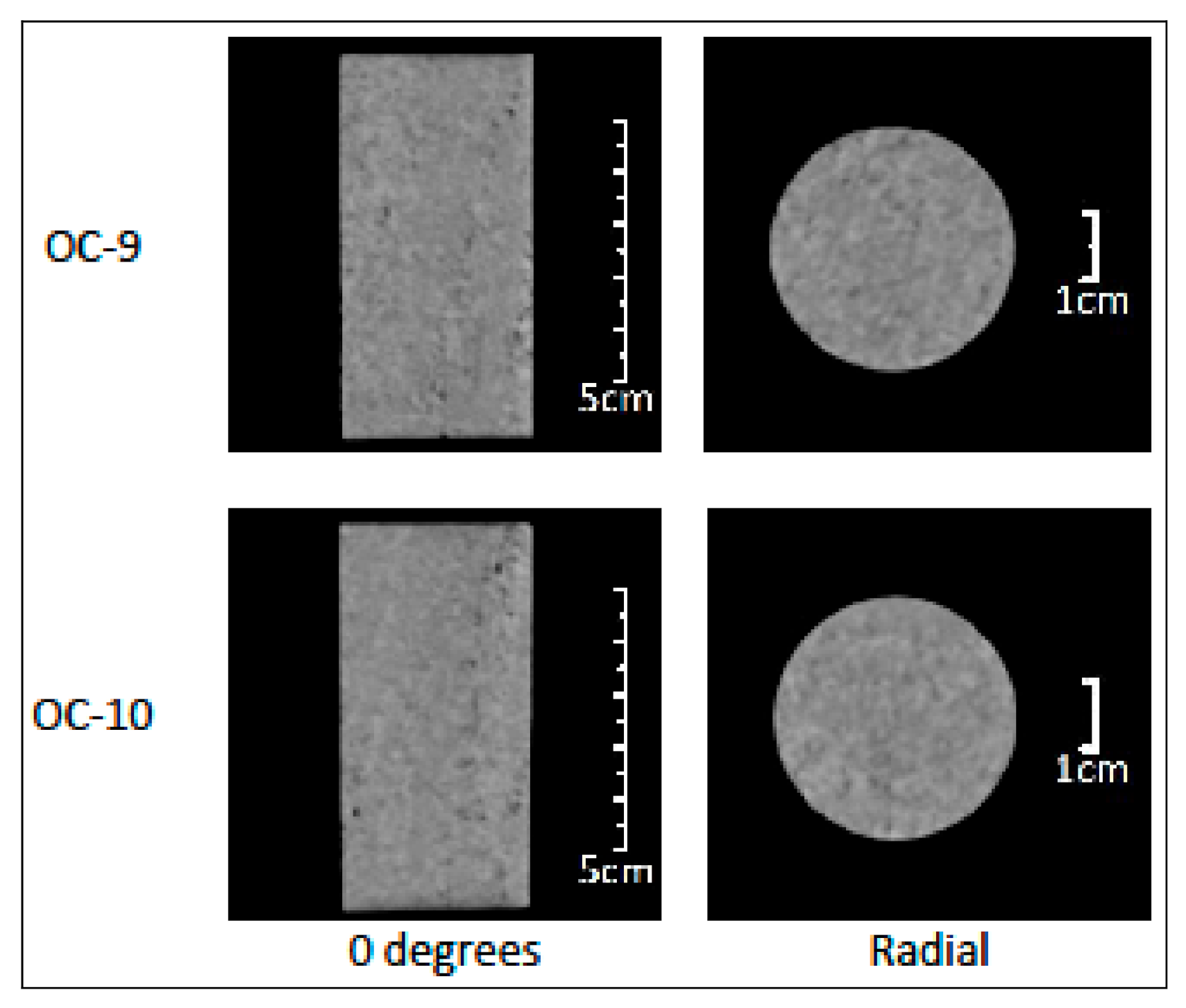
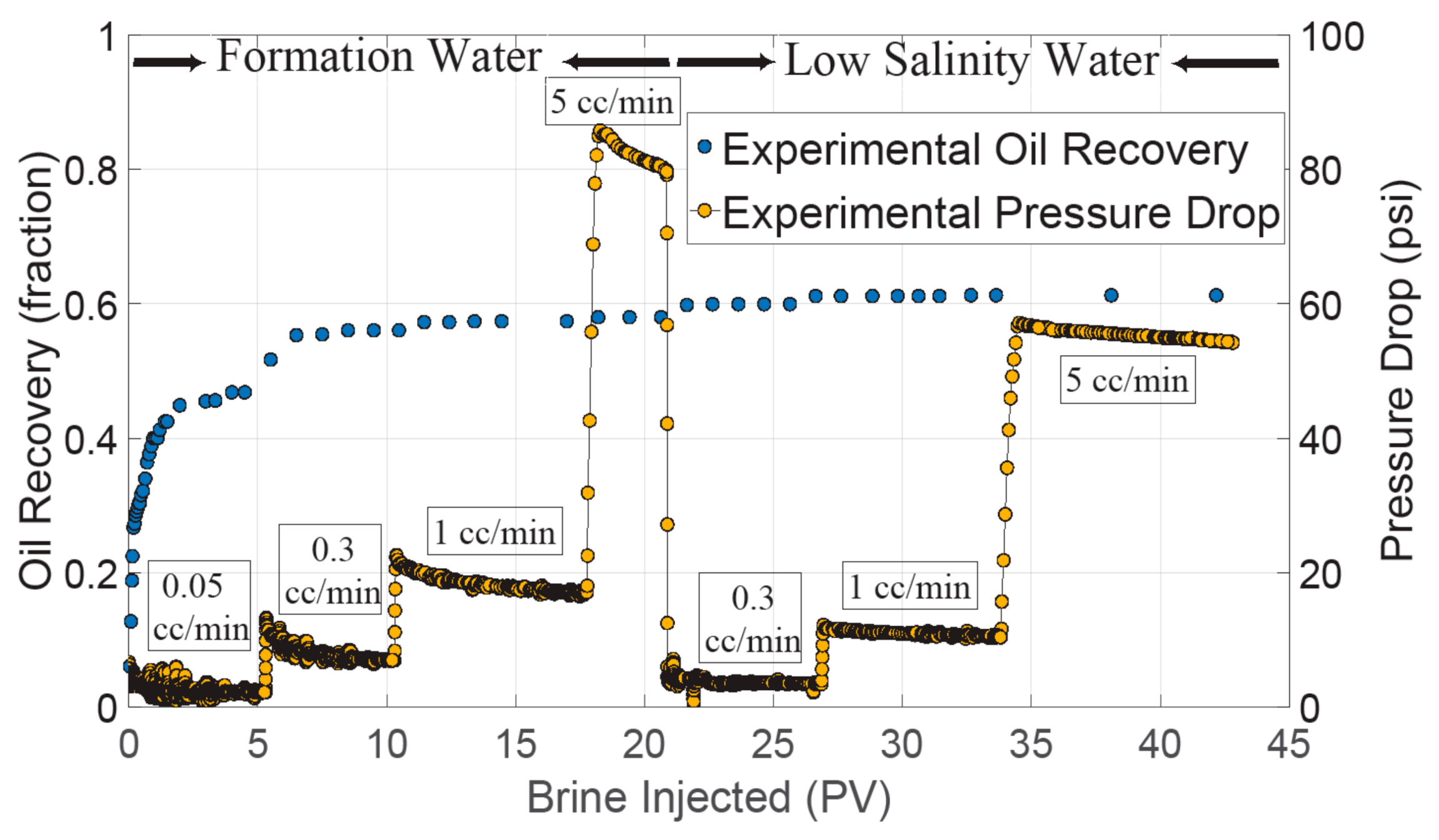
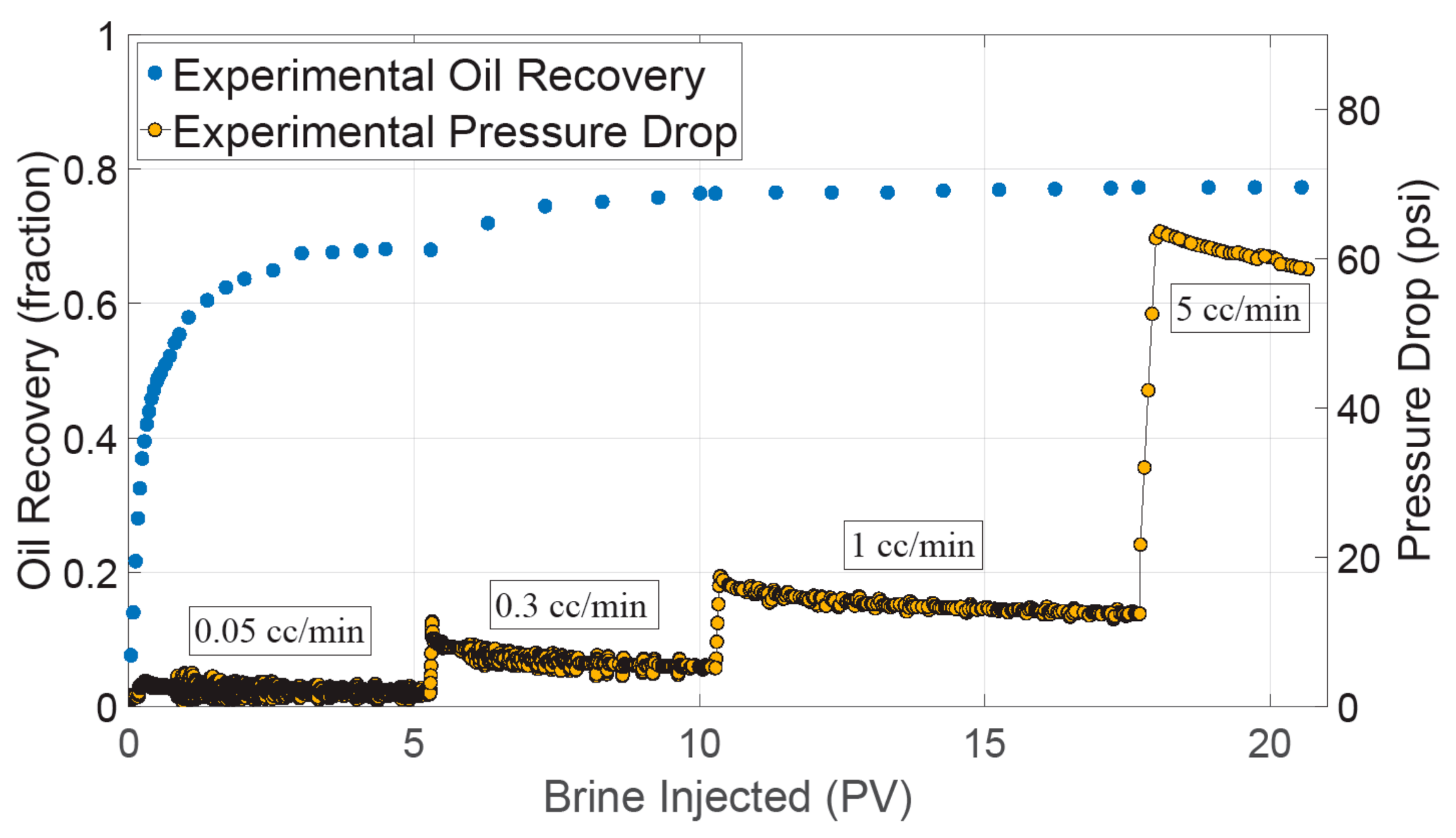



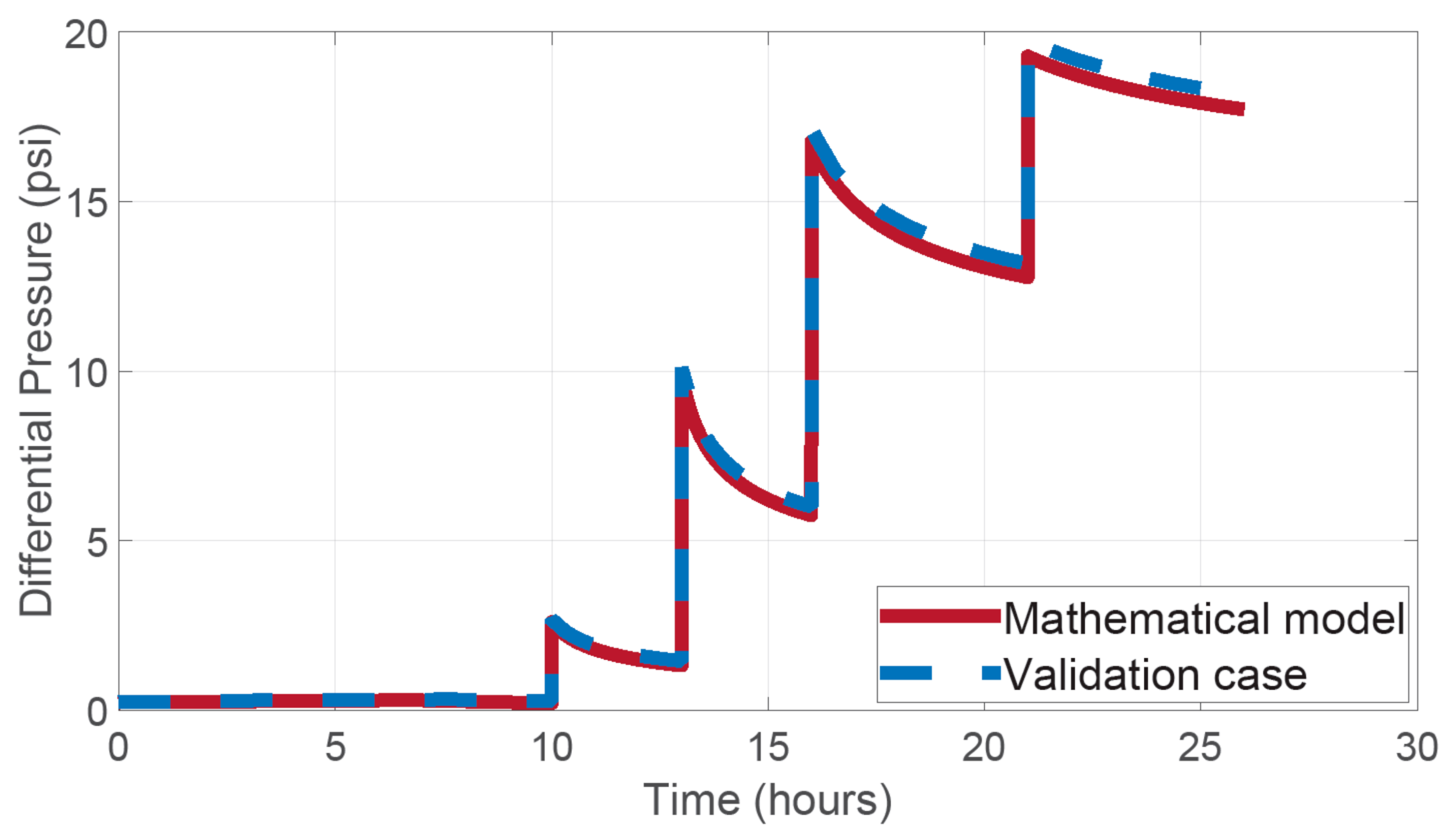

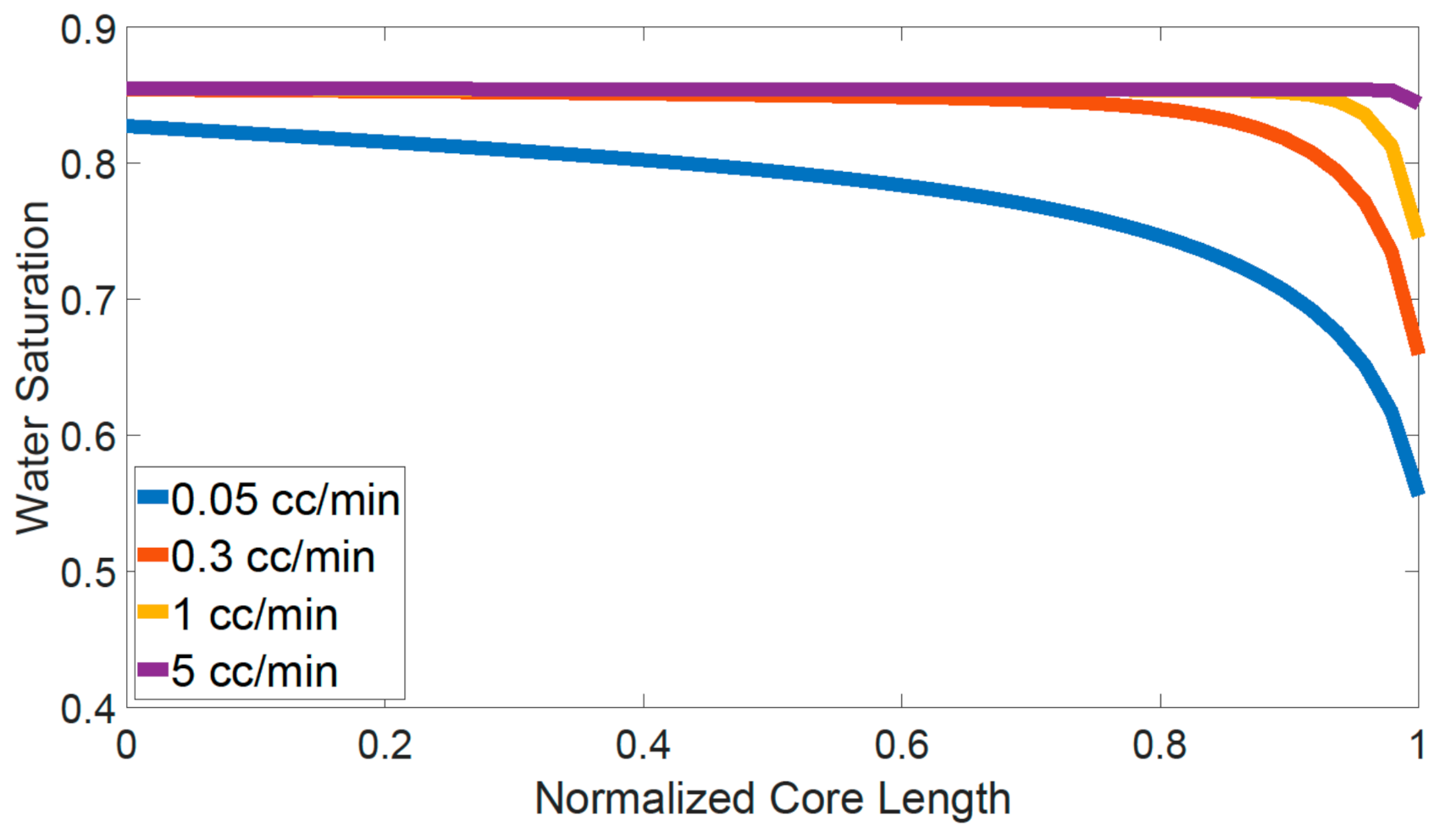




| Ion | FW | SW/50 |
|---|---|---|
| Na+ | 44,261 | 335 |
| Ca2+ | 13,840 | 14 |
| Mg2+ | 1604 | 43 |
| K+ | 0 | 13 |
| Cl− | 96,560 | 619 |
| SO42− | 885 | 79 |
| HCO3− | 332 | 2 |
| Viscosity (cP) @ 3000 psi, 120 °C | 0.36 | 0.25 |
| Density (g/cm3) @ 3000 psi, 120 °C | 1.019 | 0.959 |
| Total dissolved solids (mg/L) | 157,482 | 1105 |
| Sample ID | OC-9 | OC-10 |
|---|---|---|
| Length (cm) | 7.46 | 7.49 |
| Diameter (cm) | 3.77 | 3.77 |
| Porosity (%) | 14.74 | 14.72 |
| Air permeability (mD) | 10.25 | 9.49 |
| Brine permeability (mD) | 7.59 | 5.45 |
| Effective oil permeability (mD) | 5.91 | 2.13 |
| Pore volume (cm3) | 12.27 | 12.30 |
| NMR cut-off (%)—T2cuttoff = 100 ms | 8.1 | 7.4 |
| Swi (%) | 36 | 33 |
| Core Sample Length (cm) | 7.99 |
| Core sample diameter (cm) | 4.00 |
| Permeability (mD) | 100 |
| Porosity (%) | 25 |
| Water viscosity (cP) | 1 |
| Water density (g/cm3) | 1 |
| Oil viscosity (cP) | 5 |
| Oil density (g/cm3) | 0.8 |
| Time (h) | Injection Rate (cm3/h) |
|---|---|
| 10 | 1 |
| 13 | 10 |
| 16 | 70 |
| 21 | 200 |
| 26 | 300 |
Publisher’s Note: MDPI stays neutral with regard to jurisdictional claims in published maps and institutional affiliations. |
© 2021 by the authors. Licensee MDPI, Basel, Switzerland. This article is an open access article distributed under the terms and conditions of the Creative Commons Attribution (CC BY) license (https://creativecommons.org/licenses/by/4.0/).
Share and Cite
Chaabi, O.; Al Kobaisi, M.; Haroun, M. Quantifying the Low Salinity Waterflooding Effect. Energies 2021, 14, 1979. https://doi.org/10.3390/en14071979
Chaabi O, Al Kobaisi M, Haroun M. Quantifying the Low Salinity Waterflooding Effect. Energies. 2021; 14(7):1979. https://doi.org/10.3390/en14071979
Chicago/Turabian StyleChaabi, Omar, Mohammed Al Kobaisi, and Mohamed Haroun. 2021. "Quantifying the Low Salinity Waterflooding Effect" Energies 14, no. 7: 1979. https://doi.org/10.3390/en14071979






